OFA-100 instructions
OFA-100 instructions.doc
Emergency Contingency Fund for Temporary Assistance for Needy Families (TANF) Programs
OFA-100 instructions
OMB: 0970-0366
Instructions for Completing Form OFA-100
Emergency Fund Request Form (OMB Control # 0970-0366, expires 12/31/2009)
Purpose
Public Law 111-5 established the Emergency Contingency Fund for State TANF Programs (Emergency Fund) as section 403(c) of the Social Security Act (the Act). The Emergency Fund provides up to $5 billion to help States, Territories, and Tribes (hereafter referred to as “jurisdictions”) in fiscal year (FY) 2009 and FY 2010 that have an increase in assistance caseloads and basic assistance expenditures, or in expenditures related to non-recurrent short-term benefits or subsidized employment, compared to the lower of FY 2007 or FY 2008.
A jurisdiction administering the Temporary Assistance for Needy Families (TANF) program wishing to apply for emergency funds for FY 2009 or FY 2010 must complete and submit form OFA-100 in accordance with these instructions. Please refer to Policy Announcement TANF-ACF-PA-2009-01 for further information about the Emergency Fund.
Application Dates
A jurisdiction applies for emergency funds by fiscal quarter. Each time it applies for emergency funds for a quarter or updates data, it must submit form OFA-100. A jurisdiction may apply for a quarter one month before the start of that quarter. The following table illustrates when a jurisdiction may first apply for funding related to each Emergency Fund quarter. At any point, a jurisdiction may also apply for any past Emergency Fund quarters.
|
First opportunity to apply for: |
March 2009 |
Quarter 3, FY 2009 (April – June 2009) |
June 2009 |
Quarter 4, FY 2009 (July – September 2009) |
September 2009 |
Quarter 1, FY 2010 (October – December 2009) |
December 2009 |
Quarter 2, FY 2010 (January – March 2010) |
March 2010 |
Quarter 3, FY 2010 (April – June 2010) |
June 2010 |
Quarter 4, FY 2010 (July – September 2010) |
To expedite review and reduce confusion, we would prefer that a jurisdiction submit form OFA-100 only once in a quarter.
Once a jurisdiction has received emergency funds, it must submit form OFA-100 in each subsequent quarter to update data. For instructions about revising data submitted in prior quarterly submissions, please refer to the section labeled “Revisions” below.
After September 1, 2010, we will not accept an initial request for funding for any quarter to allow sufficient time to obligate all emergency funds before September 30, 2010, when the program expires. We will accept revisions to prior data after that date.
All jurisdictions must submit final Emergency Fund data by March 31, 2011. After that date, a jurisdiction should correct data in error, but such a correction will not result in the awarding of additional emergency funds. We will only use corrections after that date to reduce overpayments of emergency funds.
Submission
We have designed form OFA-100 so that a jurisdiction can complete it electronically. We do not have a mechanism for on-line completion of the report and need to receive a completed, signed certification page. We prefer to receive electronic copies of the report in the original Microsoft Word format, as well as a certification page in hard copy (or a scanned image of the hard copy), but you may opt to submit the entire report in hard copy. Submit the original to:
Office of Family Assistance, Attention: Emergency Fund
Administration for Children and Families, 5th Floor East
370 L'Enfant Promenade, S.W., Washington, DC 20447
Or by email to: TANFEmergencyFund@acf.hhs.gov.
Also, submit a copy to the TANF Program Manager in your Region.
The Paperwork Reduction Act of 1995
Public reporting burden for this collection of information is estimated to average 24 hours per response, including the time for reviewing instructions, gathering and maintaining the data needed, and reviewing the collection of information. An agency may not conduct or sponsor, and a person is not required to respond to, a collection of information unless it displays a currently valid OMB control number.
General Instructions
Form OFA-100 consists of five parts in a single Microsoft Word file. In Part 1, a jurisdiction submits initial and revised data on the quarters for which it is requesting or has requested funds. In Part 2, a jurisdiction briefly describes its program, the reasons for expenditure increases, and methodology for any estimates. In Part 3, a jurisdiction lists changes to the structure of its TANF program in the three funding categories and describes the methodology it used for any adjustments to the data. In Part 4, a jurisdiction provides quarterly data for the two possible base years, FY 2007 and FY 2008. In Part 5, a jurisdiction must certify that it has included all relevant caseload and expenditure data and that the data are accurate.
Using This Form
Form OFA-100 allows you to enter information only in specific fields. These may be check boxes or larger fields where you can enter text or numbers. When you enter data, use the “Tab” key to exit and move to the next field; do not use the “Enter” key, which will add hard returns and prevent the form from functioning correctly.
These instructions provide both general information and specific directions for completing each part of this form. For your convenience, we have numbered items where you need to take specific action to complete the form.
Financial and Caseload Data
Financial data reported on this form must consist of combined Federal TANF expenditures and qualified State maintenance-of-effort (MOE) expenditures. A jurisdiction can apply for funds before the start of a fiscal quarter, therefore financial and caseload data may contain estimates. Even if the expenditures do not include estimates, they may not be final when first reported on the OFA-100. Expenditures for a quarter should reflect the amount actually expended for that particular quarter (or estimated to be expended for that quarter, if data include projections for the upcoming quarter or are otherwise not final), irrespective of when the jurisdiction reports them on a TANF financial report. This is true whether the expenditures are for a quarter in the base year or for a request quarter. Expenditures you submit to apply for emergency funds must be consistent with those you report on your TANF financial report (e.g., the ACF-196 for States), but they might not be the same as the amounts reported on any given quarter’s report. This is because TANF financial reports often reflect adjustments to prior data and because the timing of claims on those reports does not necessarily have to correspond to the period of actual expenditure.
When applying for emergency funds, you must report all expenditures for an Emergency Fund category in the base-year quarters. You must report all such expenditures whether or not all programs within a category show increased expenditures.
In addition, it is possible for a jurisdiction to report expenditures that relate to one Emergency Fund category in more than one place on its TANF Financial Report. For example, it may report some subsidized employment expenditures under the category “work subsidies” on the TANF Financial Report and additional ones under the “other” category. When applying for emergency funds, you should be sure to include all expenditures for a category, regardless of how you report them on your TANF Financial Report. This applies to base-year quarters and request quarters.
Caseload data reported on this form must consist of combined TANF and separate State program (SSP-MOE) assistance cases. These data should be the same as those you report on your respective TANF/SSP-MOE data reports (e.g., the ACF-199 for States and Territories).
Administrative Expenditures
A jurisdiction may include the administrative costs associated with each type of expenditure measured by the Emergency Fund with the expenditures for a category. While administrative costs are not program expenditures, they are necessary to permit the program to operate and to incur basic assistance, non-recurrent short-term benefit and subsidized employment costs. Therefore, a jurisdiction may opt to include associated administrative costs with each category under the Emergency Fund.
If a jurisdiction does opt to include administrative costs, it must allocate the portion of its total administrative costs that are associated with each respective funding category. Thus, for example, it should only include the administrative costs associated with providing basic assistance in the basic assistance expenditures. In addition, if the jurisdiction includes the administrative costs in a request-year quarter, it must also include them in the base-year quarters.
Revisions
A jurisdiction should submit form OFA-100 once in a quarter. When you apply for emergency funds, you submit an initial request with expenditure data and, if applicable, caseload data. In each subsequent quarter, you must update the data that you submitted previously. If you are applying for emergency funds for the next quarter, you submit the initial request for the next quarter with the updates to prior data.
Definitions
For the purposes of the Emergency Fund, we are using several definitions that already exist in regulations or in various reporting instruments as well as some additional technical terms we have adopted to help this process work smoothly. Those definitions appear in Appendix 1 to these instructions for reference.
Instructions for Completing Part 1, Request Quarter Data
Part 1 consists of two tables for entering request-quarter data, one for FY 2009 and one for FY 2010, and a table related to administrative costs. When you use this part, you will be applying for funds for the first time for one or more quarters, updating data for quarters for which you previously requested emergency funds, or both.
Once you receive emergency funds, you must update the data in each subsequent quarter until the data are final. If the data for a quarter changed in any of the categories since your previous quarterly submission, enter the revised data and check the box marked “revised” at the top of the column. If the prior data did not change, re-enter the quarterly data. In either case, you should enter the most current data.
As you revise prior data, we will revise the amount of your Emergency Fund award. For example, if your revised data show that you qualify for additional emergency funds, we will increase your award. If your revised data show that you qualify for a smaller award than you received, we will adjust your award accordingly or have you remit the difference if you already expended the funds.
Enter the name of your jurisdiction. Use the “Tab” key to exit the field and move to the next one, rather than the “Enter” key.
Enter the date you are completing this form. You will only need to enter the jurisdiction name and the completion date once for each submission. These fields will appear on each page in the form. Be sure to update the completion date each time you submit the form. If you need to change the completion date, you must do so in Part 1. You must use the “Tab” key to exit the field before it will update the remaining pages of the form.
Enter the most current data available for all the categories and quarters for which you are applying. Be sure to enter total expenditures (Federal plus MOE) when entering expenditure data. Use the “Tab” key to exit a field and move to the next one, rather than the “Enter” key. Remember that you are permitted to apply for a given quarter no earlier than one month before that quarter begins. Please refer to the “Application Dates” section above for further information about when to apply for funds.
If you have updated any data for a quarter from a previously approved submission, check the box at the top of the column for that quarter. If the data for a prior quarter have not changed, enter the same data you entered before without checking the box for the quarter. (If you are revising the form to respond to questions from ACF but have not received funding related to that submission, the changes do not constitute a revision and you should not check the box if you change the data.)
Answer the questions about administrative costs in the third table. For more information about when and how you may include administrative expenditures, please refer to “Administrative Expenditures” section above.
Instructions for Completing Part 2, Expenditure Increases
In this part, you must describe briefly the programs within each expenditure category for which the jurisdiction is requesting emergency funds and describe the causes of the expenditure increase in the request quarter compared to either possible base quarter. We do not expect a jurisdiction to provide detailed data here, but rather to include general information about the programs funded in each category and the source of expenditure increases.
Briefly describe all the benefits and services that you fund in each category for which you are requesting funds.
Briefly describe the types of expenditures that increased and the factors that contributed to the increase. If you are applying for emergency funds based on an estimate, explain the basis for the estimate. For example, for the basic assistance category, the increase might be due to growth in the caseload (due to the economy or programmatic changes) or an increase in the family benefit levels. If there are multiple factors, you should list them all.
Describe the method you used to estimate expenditures if you used estimates. For example, if you estimated subsidized employment expenditures based on a certain number of subsidized jobs at a specific rate for a set number of hours, you should provide that information here. Feel free to attach additional materials if necessary.
If you already provided these descriptions on an earlier submission and nothing has changed, you do not need to provide them again. Instead, indicate in the field for the category that you have described it before, preferably telling us the date of the submission on which you described it.
Instructions for Completing Part 3, Program Configuration
This part provides information on the configuration of a jurisdiction’s TANF program. A change to the way that you structure your program after the beginning of FY 2007 may make caseload or expenditure growth between base-year quarters and request quarters appear either smaller or larger than it should for Emergency Fund purposes. This part is designed to ensure that data for each request quarter and corresponding base-year quarter are comparable.
Program Configuration Changes
Part 3 begins with Section A, a set of questions about your program configuration to help us determine whether we need to make any adjustments. If you answer “yes” to one of the primary questions in Section A, you must complete Section B so we can adjust for that program configuration change. You should not make adjustments to the data yourself; instead, follow the instructions below that will provide us with the data necessary to make any adjustments.
Each primary question is followed by the secondary question: “If yes, have you completed Section B on a prior submission to account fully for these changes?” If this is the first time you are submitting form OFA-100, you will answer “no” to that secondary question. If you have submitted the form before with a “yes” to a primary question, you should have completed Section B at that time; however, your original Section B may or may not account fully for the changes now that you are submitting the form again. For example, you may have accounted for one solely State-funded program that you ended at the beginning of FY 2009, but if you then create a new one part way through the fiscal year, you would need to submit a new Section B so we could make another adjustment. Or, if you were phasing out a diversion program, you may not have projected the rate of the phase-out correctly and thus need to revise the data with updated figures. The key to this section is to ensure that you account fully for the program configuration changes.
Types of Adjustments
We will adjust data to the extent that they represent changes in funding categories, rather than actual increases or decreases in caseloads or expenditures in the Emergency Fund categories. For example, in recent years, some jurisdictions began to serve families in solely State-funded (SSF) programs. These are programs that provide benefits to TANF-eligible families, but are funded with State dollars that are not claimed as MOE. Without adjustment, a jurisdiction with a SSF program might not get full credit for any increases it experienced in its TANF/MOE caseload and spending.
We may also need to adjust for program configuration changes across Emergency Fund categories. For example, some jurisdictions served newly-approved families in initial months by providing non-recurrent short-term benefits that were not considered to be “assistance” but were “assistance-like” programs. Some of these jurisdictions have since discontinued these front-end programs in response to a recent TANF Program Instruction on this issue and enrolled families directly in a basic assistance program. Without adjustment, a jurisdiction that made this change might appear to have caseload growth even though the overall number of families served did not change.
When we make an adjustment, generally we will do it by adjusting base-year data. This will represent what the caseload or expenditures would have been in a base-year quarter if the program configuration for the corresponding request quarter had been in place during the base year.
Also, we may need to make adjustments to account for uneven claiming of expenditures across quarters. For example, a jurisdiction may pay subsidized employment contractors every six months but the timing of such payments in the base year and request year may not match. If this appears to be the case, we may average certain expenditures in both the base year and the request year, once we have data for the full year.
Step-by-Step Instructions for Completing Part 3
Answer each question in Section A. If you answer “yes” to a question, we also ask whether you have completed section B on a prior submission to account for these changes. If you completed Section B before, but you have made additional program configuration changes, you should check “no” to indicate that you have not fully described them in a prior submission.
Complete Section B if you answered “yes” to any question in Section A about program configuration changes and have not completed Section B on a prior submission that fully accounts for those changes. We have included three copies of the Section B page in this form. If you need additional pages, include them as an attachment to your submission.
You must provide documentation to support the adjustments you are proposing to the assistance caseload and expenditure data. We have provided some examples of a completed form for Part 3, Section B in Appendix 2.
In describing an adjustment, be sure to indicate whether the adjustment is positive or negative. In other words, you should indicate whether you are adding to or subtracting from base-year cases or expenditures.
Please note that you may need to provide data to adjust to both possible base years (i.e., FY 2007 and FY 2008), depending on the timing of the change to your program’s configuration. Be sure that you explain in Section B how you have addressed this issue.
If you answered “yes” to a question in Section A but the program configuration change relates to a category for which you are not requesting emergency funds, you do not have to show an adjustment for it in Section B; however, if, at a later time, you opt to apply for funding in that category, you will have to complete Section B to adjust for the program configuration change.
Instructions for Completing Part 4, Base Years
You must provide data for both possible base years, FY 2007 and FY 2008, for each category for which you are requesting emergency funds so that we can determine the correct base year for each category. Even if you only expect to request funds for some of the quarters in a fiscal year, you must provide data for each of the base-year quarters. We strongly encourage jurisdictions to provide base-year data for all categories in case you decide to apply for emergency funds in additional categories at a later date.
Each base-year data page includes four tables, one for the assistance caseload data and one for each of the three expenditure categories. For each quarter, you will enter the unadjusted caseload and expenditures by category and any adjustments to these data from Part 3 of this form. We use the term “unadjusted” caseload or expenditures to distinguish your caseload or expenditures as they occurred for a quarter from the “adjusted” caseload or expenditures that accounts for changes in the structure of your program. Please refer to the definitions in Appendix 1 for more detail.
The first time you request emergency funds, enter the unadjusted data for each quarter in each category table for both base years. If you made no adjustments in Part 3 of this form, you do not need to enter any more information in this part. Microsoft Word will calculate the adjusted caseload and expenditures, which will be identical to the unadjusted ones.
If you did provide data for adjustments in Part 3, then enter the total adjustments (i.e., the sum of all adjustments) for each respective category from your calculation in Part 3, Section B. Be sure to use a minus sign or parentheses if the adjustment is a subtraction from the base-year data. You may need to make adjustments to both base years (i.e., FY 2007 and FY 2008), depending on the timing of the change to your program’s configuration. Microsoft Word will add the adjustments to arrive at the adjusted caseload and expenditures.
If this is not your first request for emergency funds and you have revised adjustments – or the unadjusted base-year data change after your first request for emergency funds – update the data accordingly. Check the box at the top of the column for each base-year quarter that you update. Be sure to provide supporting documentation for your explaining why you have updated the unadjusted base-year data.
Instructions for Completing Part 5, Certification and Contact
You must complete a certification with each request for emergency funds.
Enter the name and title of the official certifying the request for emergency funds.
When the form is complete, the certifying official must sign it. Send us an original certification page in hard copy or a scanned image of the hard copy. For further information about submitting this form, please refer to the “Submission” section of these instructions.
Enter the name, telephone number, and email address for a contact with whom we can discuss the content of the emergency fund request should we have questions. This does not need to be the same as the official signing the form.
Appendix 1 – Definitions
We are using several definitions that already exist in regulations or in various reporting instruments (i.e., the TANF Financial Report (ACF-196), the TANF Data Report (ACF-199), the SSP-MOE Data Report (ACF-209), the Tribal TANF Data Report (ACF-343), the Territorial Financial Report (ACF-196TR), and the Tribal Financial Reports (SF-269A, ACF-196T, or ACF-102-477 Financial Report 12g)). There are also some technical terms we have adopted to help this process work smoothly. This attachment serves as a reference for all of these definitions.
Assistance caseload: The average monthly number of TANF and SSP-MOE cases receiving “assistance.” Consistent with 45 CFR 260.31(a) and 45 CFR 286.10(a), “assistance” includes cash, payments, vouchers, and other forms of benefits designed to meet a family’s ongoing basic needs (i.e., for food, clothing, shelter, utilities, household goods, personal care items, and general incidental expenses). It includes such benefits even when they are provided in the form of payments by a TANF agency, or other agency on its behalf, to individual recipients and are conditioned on their participation in work experience or community service (or any other work activity (i.e., under §261.30)). It also includes supportive services such as transportation and child care provided to families who are not employed.
Basic assistance: Consistent with 45 CFR 260.31(a)(1) and (2), and with 45 CFR 286.10(a)(1), basic assistance means cash, payments, vouchers, and other forms of benefits designed to meet a family's ongoing basic needs (i.e., for food, clothing, shelter, utilities, household goods, personal care items, and general incidental expenses). It includes such benefits even when they are provided in the form of payments by a TANF agency, or other agency on its behalf, to individual recipients, and when they are conditioned on participation in work experience or community service (or any other work activity).
This is the same definition that the ACF-196 (line 5a) uses; it is not assistance that would be reported on line 5b, 5c, or 5d of the ACF-196 (child care, transportation or other supportive services, or assistance authorized solely under prior law, if it is not basic assistance.) It can include benefits regardless of whether the parent is working or the benefit is provided in what the jurisdiction considers its basic TANF program or in another program that serves a particular subgroup of families or a particular purpose (e.g., an earnings supplement program).
Non-recurrent short-term benefits: Consistent with the definition at 45 CFR 260.31(b)(1) and 45 CFR 286.10(b)(1), non-recurrent short-term benefits means benefits designed to deal with a specific crisis situation or episode of need, that are not intended to meet recurrent or ongoing needs, and that will not extend beyond four months. This is the same definition that the ACF-196 (line 6g) uses.
Note that these benefits include those provided directly to a family and those paid to others on behalf of the family, such as a payment to a landlord. Both families receiving other forms of “assistance” and families that do not otherwise receive ongoing assistance may receive non-recurrent short-term benefits.
Subsidized employment expenditures: There is no expenditure category called “subsidized employment” but subsidized employment activities are typically reported under the category “Work Subsidies” on TANF financial reports. Consistent with the definition at 45 CFR 260.31(b)(2) and at 45 CFR 286.10(b)(2), work subsidies means payments to employers or third parties to help cover the costs of employee wages, benefits, supervision, and training. This is the same definition that the ACF-196 (line 6a1) uses. We will use this definition for the definition of subsidized employment expenditures.
Note that some jurisdictions may in the past have reported some subsidized employment expenditures in categories other than “work subsidies” on their respective financial reports. Such a jurisdiction should nevertheless include all expenditures related to operating a subsidized employment program, including the cost of overseeing the program, developing work sites, and providing training to participants, when applying for funding.
Emergency Fund base year: Either FY 2007 or FY 2008, whichever has the lower assistance caseload (for the basic assistance category) or lower expenditures (for the non-recurrent short-term benefits and subsidized employment categories). The base year for a jurisdiction could be different for different expenditure categories. Since HHS may adjust the caseload and expenditure data, the base year for each category is the one that is the lesser after making any adjustments.
Unadjusted caseload: The average monthly number of TANF and SSP-MOE cases receiving “assistance” as reported on jurisdiction’s TANF data report for a quarter.
Unadjusted expenditures: The total Federal and MOE expenditures a jurisdiction made in TANF and SSP-MOE programs in an Emergency Fund category, where expenditures reflect the amount actually expended for a quarter, irrespective of when the jurisdiction claimed the expenditures on the applicable financial report.
Adjustment: The number of cases or amount of expenditures that should be added or subtracted from a quarter in the base year due to a change in program configuration between the base year and the request year.
Solely State-funded (SSF) program: A program that provide benefits to TANF-eligible families, but is funded with State dollars that are not claimed as MOE.
Adjusted caseload: The average monthly number of TANF and SSP-MOE cases receiving “assistance” derived by adding or subtracting adjustments from the unadjusted caseload.
Adjusted expenditures: The total Federal and MOE expenditures a jurisdiction made in TANF and SSP-MOE programs in an Emergency Fund category after adding or subtracting adjustments from the unadjusted expenditure amounts.
Appendix 2 – Examples: Adjustment Descriptions and Methodologies
This appendix includes two examples of adjustments. Each example is separate, submitted by two different, hypothetical jurisdictions, thus the caseload and expenditure data are different. Each includes an example of Part 3, Section B, and of Part 4 to illustrate how to use the adjustment data in the base-year table.
Example 1, adjustment for creation of two-parent solely State-funded (SSF) program.
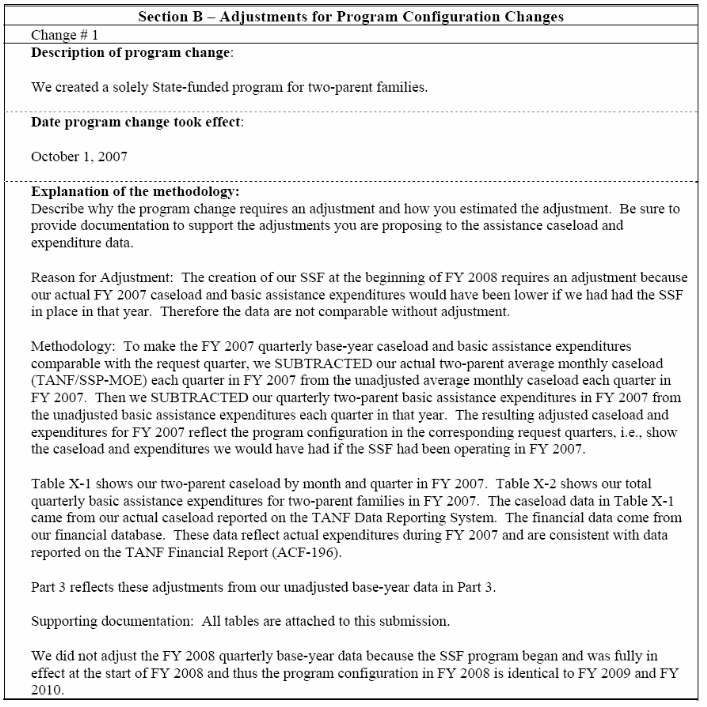
Example 1, jurisdiction’s attached tables X-1 and X-2.
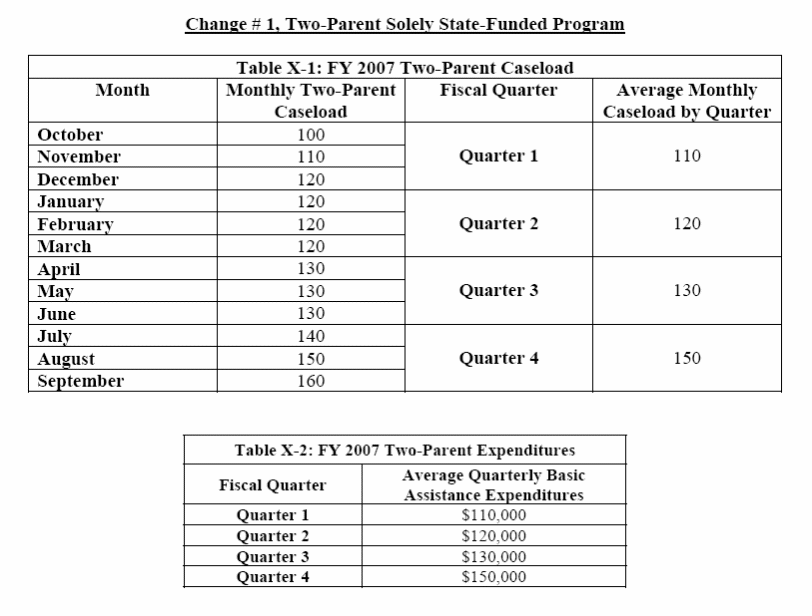
Example 1, Part 4 – FY 2007 base year with adjustments.
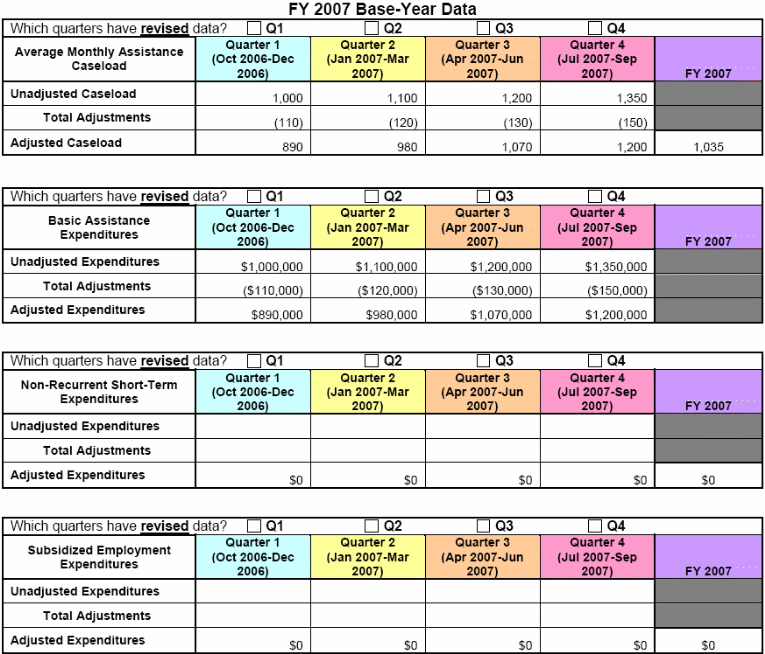
Example 2, ending an assistance-like diversion program.
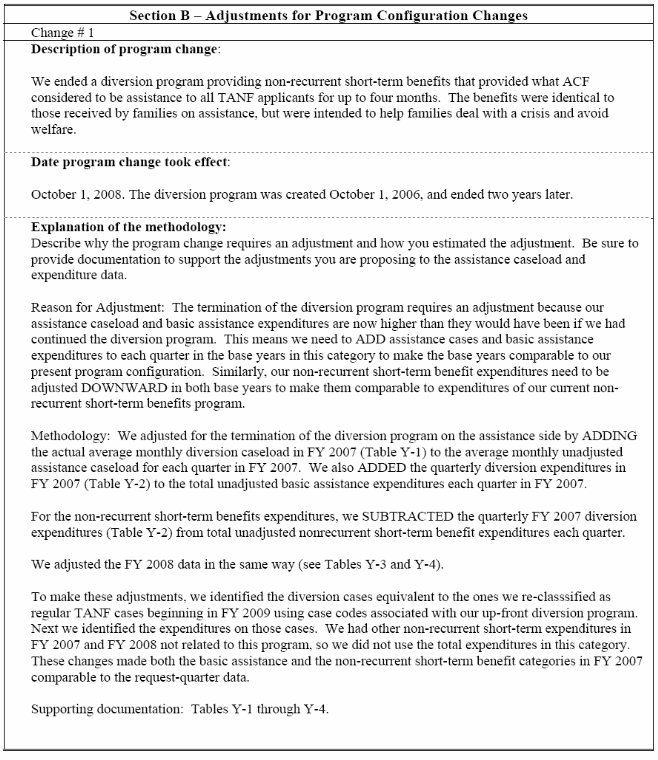
Example 2, jurisdiction’s attached tables Y-1through Y-4.
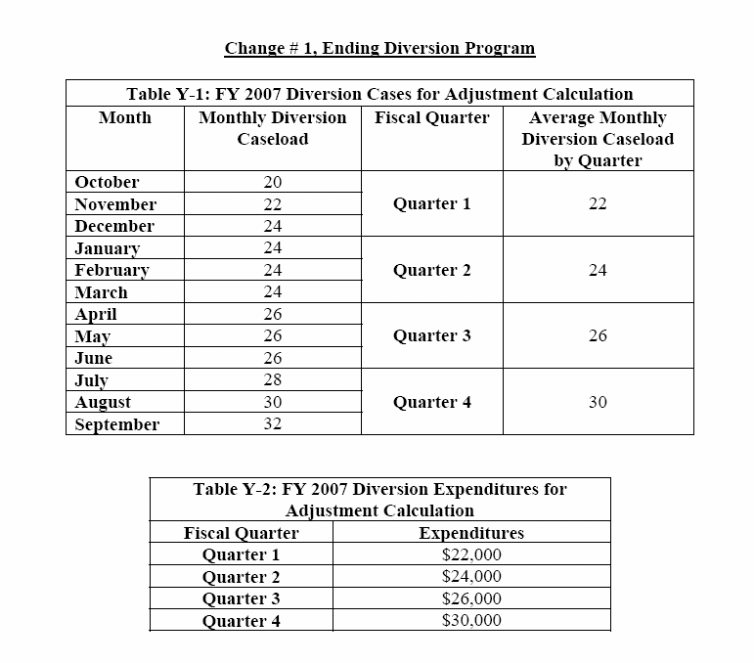
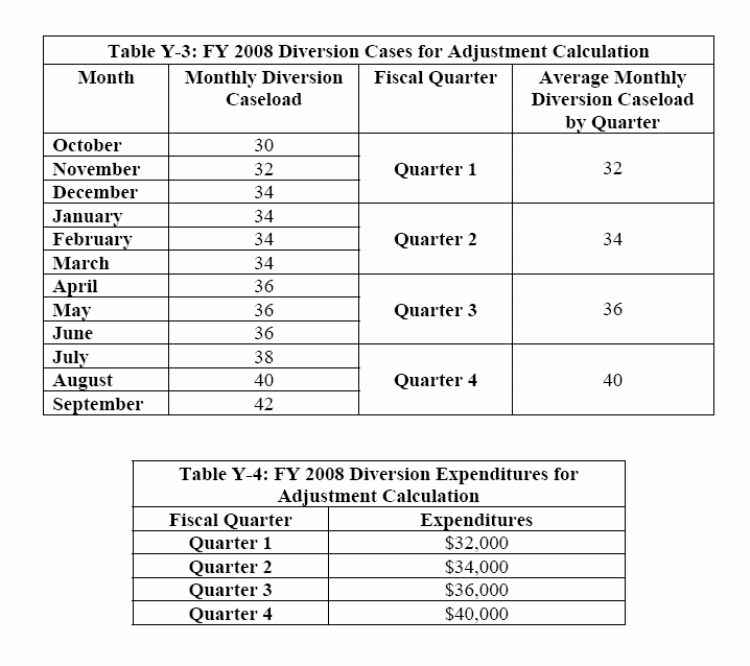
Example 2, Part 4 – FY 2007 and FY 2008 base years with adjustments


| File Type | application/msword |
| File Title | OFA-100 instructions -approved- edits 10 2009 |
| Author | ACF |
| Last Modified By | Holly Higgins |
| File Modified | 2009-10-29 |
| File Created | 2009-10-29 |
© 2025 OMB.report | Privacy Policy